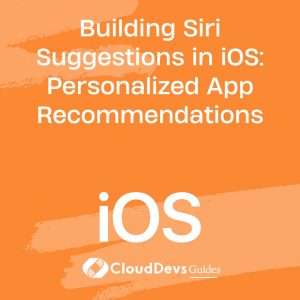Building Siri Suggestions in iOS: Personalized App Recommendations
In today’s digital age, personalization is key to enhancing user experience and engagement. With the proliferation of mobile devices, users expect their smartphones to anticipate their needs and provide relevant suggestions tailored to their interests. Apple’s Siri Suggestions feature in iOS does just that, offering personalized app recommendations based on user behavior and context. In this guide, we’ll delve into the mechanics of building Siri Suggestions for your iOS app, empowering you to leverage this powerful tool to enhance user engagement and drive app adoption.
Understanding Siri Suggestions
Siri Suggestions, introduced in iOS 9, utilizes machine learning algorithms to analyze user behavior, context, and preferences, thereby offering personalized recommendations. These suggestions manifest in various forms, including app recommendations, shortcut suggestions, proactive reminders, and more. By leveraging user data such as app usage patterns, location data, calendar events, and interactions with third-party apps, Siri Suggestions curates a personalized experience, providing users with timely and relevant recommendations.
Implementing Siri Suggestions in Your iOS App
Integrating Siri Suggestions into your iOS app involves several key steps:
1. Enable SiriKit
First and foremost, ensure that your app supports SiriKit, Apple’s framework for integrating Siri functionality into third-party apps. SiriKit enables your app to interact with Siri, allowing users to perform tasks and access content using voice commands.
2. Provide Relevant Content
To surface in Siri Suggestions, your app must provide relevant and valuable content that aligns with users’ interests and needs. Ensure that your app offers features and functionalities that users frequently engage with, as this will increase the likelihood of your app being recommended by Siri.
3. Utilize NSUserActivity
Leveraging NSUserActivity, a class provided by Apple’s UIKit framework, allows your app to provide Siri with contextual information about user interactions within the app. By marking relevant user activities with NSUserActivity, such as viewing specific content or performing certain actions, you enable Siri to understand user preferences and suggest relevant content accordingly.
4. Optimize for Relevance and Timeliness
When implementing Siri Suggestions, prioritize relevance and timeliness to enhance user engagement. Ensure that the suggested content is tailored to the user’s current context and preferences, providing value in the moment. For example, if a user frequently orders food delivery on Friday evenings, Siri may suggest your app at the appropriate time, increasing the likelihood of user interaction.
5. Handle User Privacy
Respect user privacy and ensure compliance with Apple’s guidelines regarding data usage and privacy. Obtain user consent before accessing sensitive data or utilizing personal information for Siri Suggestions. Transparency and user control are essential in fostering trust and maintaining a positive user experience.
Examples of Successful Implementation
1. Uber
The ride-sharing app Uber effectively utilizes Siri Suggestions to streamline the user experience. By integrating with SiriKit and providing relevant NSUserActivity data, Uber enables Siri to suggest ride options based on user location, recent travel patterns, and calendar events. This proactive approach simplifies the process of booking rides, enhancing user convenience and satisfaction.
2. Spotify
Music streaming service Spotify leverages Siri Suggestions to recommend personalized playlists and music recommendations to users. By analyzing user listening habits, favorite artists, and curated playlists, Spotify provides tailored suggestions that resonate with individual preferences. This integration enhances user engagement and encourages prolonged app usage.
3. Airbnb
The Airbnb app employs Siri Suggestions to offer personalized travel recommendations and accommodation options to users. By analyzing past booking history, saved listings, and travel preferences, Airbnb surfaces relevant suggestions for upcoming trips and destinations. This proactive approach simplifies the travel planning process and encourages users to explore new experiences through the app.
Conclusion
Incorporating Siri Suggestions into your iOS app presents an opportunity to enhance user engagement, drive app adoption, and deliver personalized experiences tailored to individual preferences. By following best practices and leveraging user data effectively, you can harness the power of Siri Suggestions to provide timely and relevant app recommendations that delight users and foster long-term loyalty.
In summary, building Siri Suggestions in iOS requires a strategic approach centered around understanding user behavior, providing relevant content, and optimizing for relevance and timeliness. By emulating successful implementations and prioritizing user privacy, you can leverage Siri Suggestions to differentiate your app and outperform the competition in today’s competitive app landscape.
For more insights on iOS app development and personalized user experiences, check out these resources:
- Apple Developer Documentation on SiriKit
- WWDC Session – Siri Suggestions Best Practices
- Case Study: How Airbnb Uses Siri Suggestions to Enhance User Experience
Harness the power of Siri Suggestions to elevate your iOS app and deliver exceptional user experiences that keep users coming back for more.
Table of Contents









